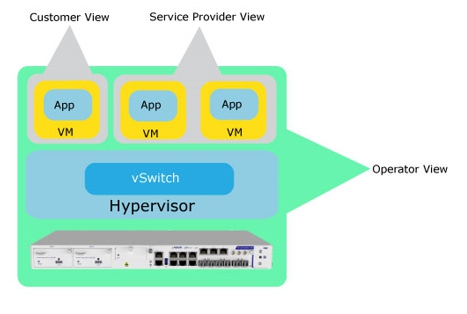I often say that network functions virtualization (NFV) brings the power of the cloud to the networking world. NFV can also be used to drive additional revenue by enabling operators to augment connectivity services with NFV hosting services. Let’s take a look at how this can work.
NFV Deployed in the Access Network
I’ve spoken frequently about how Masergy has deployed NFV at its customer sites to enable innovative and dynamic services. Oftentimes, these customers are in far-flung locations, and the use of NFV reduces the number of devices on site down to one server, as shown below.

With NFV, the previous stack of appliances (router, firewall and EAD) is replaced by a single server hosting virtual network functions (VNFs). However, that one server is still required. Masergy CTO Tim Naramore said he would like to get his footprint down to no devices. A pipe dream? No – it is definitely possible!
Services With No Boxes
Masergy typically gains access via a local operator, who also has an EAD on site, as shown above. However, the local operator can use a server or hybrid device and provide hosting for NFV infrastructure as a service (NFVIaaS), as shown below.

By offering NFVIaaS, the local provider has the opportunity to provide a valuable wholesale service for out-of-region service providers. Rather than ordering connectivity and then rolling a truck to install a server, the service provider can order access coupled with NFVIaaS. Services can now be enabled with no equipment placed on site by the service provider.
In addition to enabling wholesale services, the placement of compute nodes at the customer site can also be used to offer micro-cloud services to end users, as described here. The possibilities are endless.
How Does the Operator Maintain Control?
The problem with the NFVIaaS scenario is one of control. Both the local operator and the out-of-region service provider need to be able to access the server for their independent purposes. However, the local operator may be hosting more than one service provider on the same server. One operator refers to this situation as the “hydra problem” because one device would have multiple heads.
As the operator, how do you enable each of your service provider customers to access only their allotted resources?
The answer is carrier-class management and orchestration, or MANO. By using a solution such as ADVA Optical Networking’s Ensemble Orchestrator, the local provider can provision, allocate and maintain the NFVI.
In addition, the operator can expose application program interfaces to each of the service providers, allowing them to view, control and maintain their VNFs, using only their allocated resources. Complete separation and multi-tenancy is enforced by the orchestrator, as shown below.

Help Tim Realize His Dream
Tim and Masergy have been great partners and customers for ADVA Optical Networking. I would like to help him realize his dream of offering services without having to deploy a box.
For you operators who are looking to drive more service revenue, here’s your chance.
Tim and I thank you in advance!
